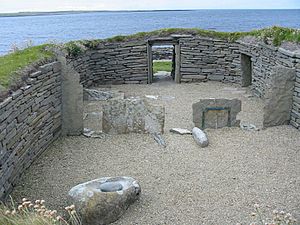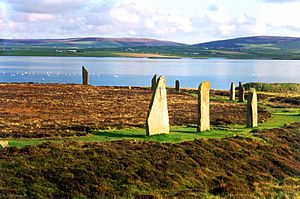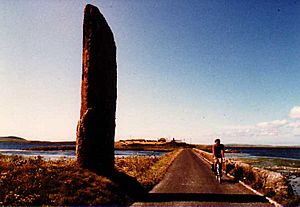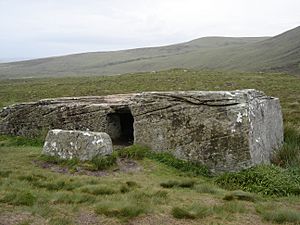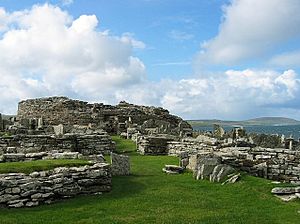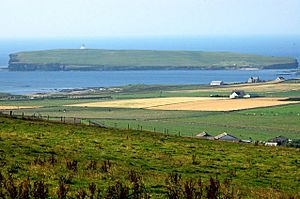Prehistoric Orkney facts for kids
Prehistoric Orkney is all about the very old times in the Orkney islands of Scotland, before people started writing down history. It's a time when humans first came to live on these islands, long before the Vikings or even the Romans.
Orkney is super special because it has so many amazing ancient sites, especially from the Neolithic period, which was when people started farming. Four of these sites are so important that they are now a World Heritage Site!
Why are there so many old remains in Orkney? Well, the local stone is easy to work with, and the sand blown by the wind has helped keep many sites safe. Also, not much building or farming has happened there over the years, which has protected these ancient places. Plus, old stories say people used to respect these sites, maybe even fear them a little, which helped keep them safe from damage.
Historians divide prehistory into different periods, like chapters in a very old book. It's tricky to say exactly when one period ended and another began because changes happened slowly. But generally:
- The Paleolithic (Old Stone Age) was when the ice from the last Ice Age melted away.
- The Mesolithic (Middle Stone Age) was before people started farming.
- The Neolithic (New Stone Age) was when farming began, and people built amazing stone structures.
- The Bronze Age followed, but there aren't as many remains from this time.
- The Iron Age saw a return to building big structures, especially cool towers called brochs.
People started formally digging up these sites in the late 1700s. At first, they didn't know much about them, but over time, archaeologists have learned a lot, turning old stories into real science! Most of the sites we'll talk about are on the main island, called the Orkney Mainland.
Contents
Ice Age Times: The Paleolithic Period
So far, no signs of humans have been found in Scotland during the really cold Ice Ages. The first clues of people living here are from after the ice melted, around 11,000 BC. Back then, sea levels were much lower because so much water was still frozen in ice. This meant that Great Britain was connected to Europe, and it's possible Orkney was connected to the mainland too! It would have been easier for early humans to travel to northern Scotland.
First Signs of Life: The Mesolithic Period
There isn't much evidence of Mesolithic life in Orkney or northern Scotland. Archaeologists have found small stone tools and chips at a few places like Seatter and Wideford Hill. They even found a burnt hazelnut shell from around 6820-6660 BC! But we don't know if people lived there all year round, and no burial sites from this period have been found.
A new dig on Stronsay found over a thousand pieces of flint and possibly a temporary camp from around 7000 BC or even earlier. This might be the oldest settlement found in Orkney!
Around 6000 BC, a huge underwater landslide off the coast of Norway caused a massive tsunami. This giant wave was about 8 meters (26 feet) high in some places and would have had a huge impact on any Mesolithic people living along the coast of Orkney.
New Ways of Life: The Neolithic Period
The amazing collection of huge Neolithic structures in Orkney is truly special. During this time, around 4000 to 2200 BC, people started farming and created complex new societies. Orkney has almost 3,000 identified Neolithic sites!
For a long time, people thought that these advanced cultures started in southern Great Britain and then spread north. But new discoveries show that Orkney was actually a starting point for many of these ideas, including building styles and pottery. These ideas then spread to the rest of the British Isles much later!
Early Homes and Burial Chambers
The Knap of Howar farmstead is probably the oldest preserved house in northern Europe. It's on the island of Papa Westray. It has two thick-walled, rounded rectangular buildings connected by a passage. People lived here for 900 years, starting around 3700 BC, but it was built on an even older settlement. This site was only found in the 1920s after a storm uncovered it.
The Barnhouse Settlement is a group of at least fifteen buildings, used between 3200-2950 BC. The houses were built above ground and had a central fireplace, stone beds, and stone shelves. They even had a system of stone drains! Archaeologists found pottery, flints, and stone tools here.
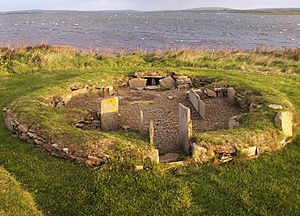
Skara Brae is a village with ten houses, and it's the most complete Neolithic village in northern Europe. People lived here from 3100 to 2500 BC. The houses are similar to those at Barnhouse, but they are connected by passages and were built into a large mound of ash, bones, shells, and other waste. Only the roofs, probably made of timber or whalebone, would have been seen from the outside. Inside, stone shelves were placed to be the first thing you saw when you entered. There are also cool carvings on some stones. Many bone beads, pins, and pendants were found here, along with four carved stone balls. A big storm in 1850 uncovered this amazing village.
There are two main types of chambered cairns (stone burial mounds) in Orkney:
- The Orkney/Cromarty type: These have a burial chamber entered through a low passage, often divided into "stalls" by stone slabs.
- The Maeshowe type: These are later, with a cross-shaped layout and a long passage.
The island of Rousay has many prehistoric sites, including fifteen of these tombs, which is why it's called the "Egypt of the north." Midhowe Chambered Cairn is a great example. Its outer walls are still very tall, and the stones are arranged in a cool pattern. The inside was later made bigger to include twelve separate rooms along a 23-meter (75-foot) passage. Other big tombs are at Blackhammer, Taversoe Tuick, and Yarso. As the Neolithic period went on, burial mounds became bigger and more complex, changing from private tombs to larger structures that might have been used for public gatherings.
At Links of Noltland on Westray island, archaeologists found a diamond-shaped figurine in 2009. It might be from 2500-3000 BC and is thought to be the earliest carving of a human face ever found in Scotland! It has two dots for eyes, thick eyebrows, and an oblong nose.
The Heart of Neolithic Orkney: A World Heritage Site
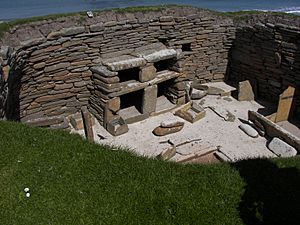
Skara Brae, Maeshowe, the Ring of Brodgar, and the Stones of Stenness are all part of the Heart of Neolithic Orkney UNESCO World Heritage Site. This small area in western Orkney has an incredibly rich archaeological history. Even though Orkney seems remote today, it was a very important place 5,000 years ago. There's strong evidence that Orkney was a leader in developing advanced societies during the Neolithic period, and ideas spread from here to the rest of Britain!
Archaeologists have also noticed that different types of pottery are found at different sites. "Unstan Ware" pottery is found at smaller settlements like Knap of Howar and stalled tombs like Midhowe. "Grooved Ware" pottery is found at larger villages like Skara Brae and Barnhouse, and with Maeshowe-style tombs. This might mean there were different groups of people or different traditions.
Maeshowe: A Special Tomb
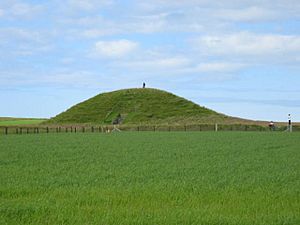
Maeshowe is a large chambered cairn and passage grave built around 3000 BC. The word "Howe" comes from an old Norse word meaning mound or barrow, which is common in Orkney. This grassy mound hides a complex system of passages and chambers made of carefully shaped sandstone slabs. It's truly amazing for its size and how well it was built. It's even lined up so that the back wall of its central chamber is lit up by the sun on the shortest day of the year (the winter solstice)! Maeshowe gives its name to a type of chambered cairn, including other important sites like Cuween Hill and Quanterness.
After it stopped being used in the Bronze Age, Vikings reopened Maeshowe between the 9th and 12th centuries AD. These Norsemen left over thirty runic carvings on the stone walls, which is one of the largest collections in Europe! Some were even left by a group of crusaders in 1153-54.
Ring of Brodgar: A Giant Stone Circle
The Ring of Brodgar is a huge stone circle, 104 meters (341 feet) across. It originally had 60 stones, but only 27 are still standing. It's surrounded by a circular ditch up to 3 meters (10 feet) deep and 10 meters (33 feet) wide. Some stones are 4.5 meters (15 feet) tall! Experts think the ditch alone took 80,000 hours of work to build. The ring stands on a narrow strip of land between the Lochs of Stenness and Harray, and it was probably built between 2500 BC and 2000 BC.
Ness of Brodgar: A Temple Complex
Excavations at the nearby Ness of Brodgar, between the Ring and the Stones of Stenness, have uncovered several buildings, both for ceremonies and for living. One building is huge, about 20 meters (66 feet) long and 11 meters (36 feet) wide! Archaeologists found pottery, bones, stone tools, and polished stone mace heads.
Perhaps the most exciting find was a large stone wall, possibly 100 meters (328 feet) long and 4 meters (13 feet) wide. It seems to cross the whole peninsula and might have been a symbolic barrier between the special ceremonial area of the Ring and the everyday world around it.
In 2010, a rock colored red, orange, and yellow was found. This was the first time evidence of Neolithic people using paint to decorate their buildings was found in Britain! They think the paint might have been made from iron ore mixed with animal fat, milk, or eggs. A week later, a stone with a zigzag pattern painted in red was found nearby.
More recent digs have revealed a huge temple complex at this site, unlike anything else in western Europe. It has more than a dozen large temples connected to other buildings by carefully built stone paths. Nick Card, the director of the digs, said in 2012 that Orkney was the "center for innovation for the British Isles" 5,000 years ago, and ideas spread from here!
Stones of Stenness: Ancient Standing Stones
The Stones of Stenness are five tall stones that are part of a henge. The tallest stone is 6 meters (20 feet) high! This site is thought to be from 3100 BC, making it one of the earliest henges in Britain. The Stones are in an area that was clearly very important for ceremonies for the "Grooved ware people." The Ring of Brodgar is about 1.2 kilometers (0.75 miles) away, and Maeshowe is a similar distance. Barnhouse is only 150 meters (492 feet) north.
These stones were originally part of an oval stone circle of 12 stones, about 32 meters (105 feet) across, surrounded by a ditch. The Watch Stone stands outside the circle and is 5.6 meters (18 feet) high. Other smaller stones, like a square stone in the center, along with animal bones found in the ditch, suggest that special ceremonies and feasting took place here.
Even in the 1700s, people still connected the site with old traditions, by then linked to Norse gods. The "Odin Stone" had a hole in it, and local couples would hold hands through it to promise to marry. In the early 1800s, a new landowner decided to remove the stones because people were using his land. He started by smashing the Odin Stone in 1814! This caused a huge outcry, and he was stopped after destroying one more stone and toppling another. The toppled stone was put back up in 1906.
Other Late Neolithic Sites
The Isbister Chambered Cairn, also known as the "Tomb of the Eagles", is on the cliffs of South Ronaldsay. This burial tomb was used for over 800 years, starting from 3150 BC. It has five separate stalls and three side-chambers. During digs, archaeologists found 16,000 human bones, 725 bird bones (mostly from white-tailed sea eagles), and over 25 kg (55 lbs) of pottery pieces!
The Dwarfie Stane tomb on the island of Hoy is very unique. It's made from a single, huge block of red sandstone with a hollowed-out chamber inside. This style is different from any other Neolithic site in Orkney and probably dates from around 2500 BC. It was the first ancient monument in Orkney to be written about in the 1500s. The writer said it was built and used by giants!
The Bronze Age: A Quieter Time
The Bronze Age in Scotland lasted from about 2200 BC to 800 BC. There aren't as many remains from this period in northern Scotland compared to the Neolithic or Iron Age. This might be because the weather got worse. In Orkney, fewer large stone structures were built. People started burying their dead in small stone boxes called cists, away from the big stone circles. A new "Beaker" culture also arrived. However, the great ceremonial stone circles continued to be used as bronze metalworking slowly came to Scotland from Europe.
There are some Bronze Age sites on the Mainland, like Knowes of Trotty, and on other islands like Tofts Ness on Sanday.
The Iron Age: Towers and New Influences
Early Iron Age Buildings
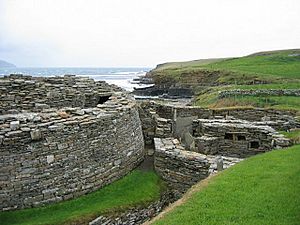
The Iron Age has many impressive building remains. In the 1970s, digs at Quanterness found an "Atlantic roundhouse" built around 700 BC. It was made using stones taken from the older Neolithic tomb that had fallen out of use. Many similar finds have been made.
There are also many impressive broch sites. Brochs are large stone towers that grew out of the roundhouse tradition in northern and western Scotland. Their dry-stone walls might have been as tall as 13 meters (43 feet)! Even though no broch walls in Orkney are still that tall, several important sites have been dug up that show many buildings around the broch, forming a "broch village."
Midhowe Broch is near the chambered cairn of the same name on Rousay. It seems to have been used at least twice, and at some point, extra supports were added to the outside walls, suggesting it needed strengthening. It's one of 11 broch sites along the Eynhallow Sound. Burroughston Broch on Shapinsay island was built in the second half of the first millennium BC. Its earth covering is still there, so visitors can look down into the broch from above. The walls are up to 4 meters (13 feet) thick in places, and there's a complete room off the entrance passage. You can still see the remains of stone furniture inside.
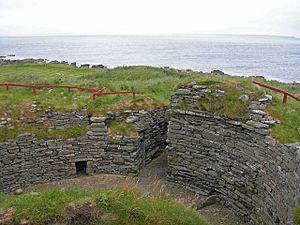
Mine Howe, near Tankerness, is a man-made underground chamber dug 7 meters (23 feet) deep inside a large mound. Its purpose isn't clear. The walls are lined with stones that form an arch, and steep steps lead down to a rock floor. There's also evidence of advanced metalworking around the site. The Rennibister Earth House is an underground passage with an oval chamber and a roof supported by pillars. While these structures are usually for storing food, this one looks like the Neolithic tombs, and archaeologists found 18 human skeletons inside!
"Wheelhouses" are stone buildings from the later Iron Age. They have an outer wall with a circle of stone pillars inside, which look like the spokes of a wheel. These pillars supported the roof, and there was a fireplace in the middle. Eight possible wheelhouse sites have been found in Orkney.
The Romans and Picts
For a short time, Orkney appeared in written history because of the Romans. The Greek explorer Pytheas visited Britain around 322-285 BC and might have sailed around the mainland, possibly mentioning Orkney.
Amazingly, the first written record of a connection between Rome and Scotland is when the "King of Orkney" was one of eleven British kings who met the Roman Emperor Claudius in AD 43. This was just three months after the Romans invaded southern Britain! This suggests there was some connection between Rome and Orkney even before this, though we haven't found much evidence. Roman pottery has been found at the Broch of Gurness, and Roman coins from the 1st and 2nd centuries have been found at Lingro broch.
However, the Romans didn't stay in Scotland for long. As their power faded after AD 211, Orkney went back to its Celtic Iron Age way of life, mostly unchanged.
In the centuries after the Romans left, Orkney was part of the Pictish kingdom for a while. We don't know much about the Pictish people of Orkney, but the main clues are "symbol stones" with carvings. One of the best is on the Brough of Birsay, a small island that you can walk to at low tide. It shows three warriors with spears and swords, along with traditional Pictish symbols. This island has been settled for a very long time, even into the Norse period.
Christianity probably arrived in Orkney in the 500s AD. An interesting artifact called the Buckquoy spindle-whorl, found at a Pictish site on Birsay, has Ogham writing on it, which is thought to be Irish and Christian. Evidence suggests that the St Boniface Church on Papa Westray might have been the center of the Christian church in Orkney during Pictish times.
The 700s AD was also when the Vikings started invading the Scottish coast. With them came a new culture and language for the Orkney islands. The Norse era has many written records, like the long Orkneyinga Saga, and from this point, Orkney fully enters the historical period.
Archaeological Discoveries Over Time
The first formal digs were recorded at Earl's Knoll on Papa Stronsay in 1795. Like the Dwarfie Stane, people thought the mound was a giant's grave back then. More work happened in the mid-1800s, with about a dozen chambered tombs being dug up.
Then there was a quiet period for about sixty years. But from the late 1920s, work started again. A very famous archaeologist named Vere Gordon Childe worked at Skara Brae and Rinyo. It was only when a piece of pottery was found at Rinyo that people realized these settlements were from the Neolithic period, not the Iron Age, as they had thought!
By the 1960s, we had a good understanding of Orkney's prehistory. The invention of radiocarbon dating helped set even more accurate dates. This also proved wrong earlier ideas that Orkney's chambered tombs came from similar structures in the Mediterranean. It turned out that Orkney's tombs were built much earlier!
Neolithic Timeline

See also
 In Spanish: Orcadas prehistóricas para niños
In Spanish: Orcadas prehistóricas para niños



